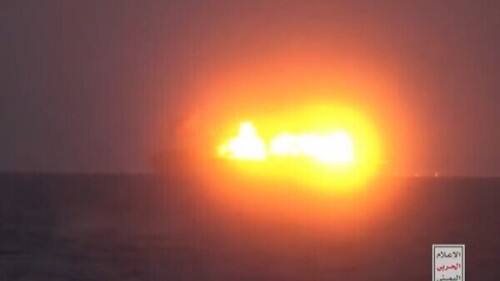Violence has increased in the West Bank this year. This has included numerous incidents in which Palestinians have clashed with Israeli security forces or where individuals have tried to commit terrorist attacks. There is also another increasing phenomenon of clashes between Palestinians in Nablus. In the recent confrontations, which occurred after the Palestinian Authority arrested two Hamas members, one person was killed and 55 others were injured.
The clashes appear to be a challenge to the control and power of the PA. There have always been some areas of the West Bank that are out of the full control of the Authority, or where armed men frequently parade and don’t seem to be under the control of either Israel or the PA. In addition there have been similar clashes in Jenin over the years, as well as frequent raids by the Israel Defense Forces. There have also been feuds that broke out into larger battles between Palestinians in Hebron and other places.
Consensus appears to be growing that the violence will spill over. “West Bank violence is prelude to uprising against PA,” read a headline at Ynet this week. Haaretz says that “with uprising in Nablus, the Palestinian Authority‘s fall becomes a palpable threat.” Everyone seems to be watching the unfolding events closely, from writers at Middle East Eye to the Electronic Intifada website.
As commentators and writers, as well as those interviewed by them, watch the unfolding events, a sort of group think or meta narrative is forming: The violence has the makings of an uprising against the Palestinian Authority, and Israel is to blame.
The Guardian wrote this week, “This Israeli strategy of attrition known as ‘mowing the grass’ has two goals: diminishing the enemy’s ability to attack, and temporary deterrence. But rather than quashing Palestinian armed resistance, Operation Breakwater appears to be fueling more violence in the West Bank – and galvanizing a new generation of fighters.”
This article has the usual talking points. The youthful men who were interviewed – and they seem to have only talked to young Palestinian men not any young Palestinian women – say they have easy access to firearms and that they don’t believe in peace. They are contrasted with their parents, who lived through the First and Second intifadas, and do believe in peace. It’s not clear if anyone investigated how easy it is to actually get firearms in the West Bank. The men may not have the kind of access they brag about.
Nevertheless, The Wall Street Journal has heard the same narrative. A recent article about how “young Palestinians battle Israeli troops and the Palestinian Authority” also sees these young men as leaderless and hopeless, but willing to confront the “discredited” PA.
The Palestinian narrative
At the heart of the discussion about the new round of violence is a known fact: Today’s young men have no personal memory of the Second Intifada. Articles conclude that they kind of have a “right” to gun violence, especially if they lack “hope.” In the old days, this “right” to guns and killing was termed “armed struggle” or “resistance,” or was known by various other terms.
Armed struggle supposedly brought about the creation of the PA and eventually led to Hamas taking over Gaza after Israel withdrew. But at each juncture, the Jewish state is still blamed for whatever occurs. Israel keeps Hamas under blockade, thus creating the conditions for Hamas to need to “resist” – even though it was the terrorist group’s mass murdering of Israelis and endless firing of rockets that led to the blockade.
In Lebanon, even after Israel left in 2000, Hezbollah claimed that it still occupied some sliver of rock and grass on Har Dov (Shebaa Farms) and thus Hezbollah had to “resist.” The “resistance” has now swallowed Lebanon, bankrupting and ruining it, and expanding its arsenal of rockets from some 10,000 just 20 years ago to 150,000 today. Hamas has also grown its arsenal.
The Israeli relationship with the PA is also a lose-lose situation. If its security forces work with Israel, they are “collaborators,” so the more security they impose, the more they are to blame for anger in the West Bank. But if they don’t do anything, then violence and lawlessness grows, and Israel is again blamed for the resulting violence because people lack “hope.”
If Israel goes into cities like Jenin and Nablus on armed raids, then it is responsible for causing anger. If it doesn’t go in, then the Palestinian Authority is blamed for heavy-handed “collaboration.” If no one does anything, then the chaos is the fault of both Israel and the Palestinian Authority.
Groups like Hamas then come into the vacuum and take over, as they did in Gaza, and any resulting blockade would result in more lack of hope and a perceived need for armed struggle. And letting Hamas take over and the suffering caused by the blockade would, of course, be Israel’s fault. It’s a feedback-loop endless “cycle” of violence with diminishing returns, confirmation bias, sunk costs and clichés all wrapped into one.
How did we end up here?
LOOKING AT the whole situation today with any kind of clarity, the story breaks down like this: The Oslo Accords led to the creation of the Palestinian Authority, a kind of state-in-the-making. This emerging Palestinian state has been recognized by some countries.
But the situation was predicated on the fact that the Authority generally sold its people extreme nationalism as a way to distract from its lack of success. There were “martyrs” and maps of Palestinian “return.” The Second Intifada led to Israel’s withdrawal from Gaza and Palestinian elections, which led to a Hamas coup in the coastal enclave. The rise of the Palestinian Security Forces, trained with US support, created the modern status quo – and Israel was blamed for preferring a divided Palestinian polity while Jerusalem concentrated on building up its economy and reaching peace with the Gulf States.
The end result is an aging Palestinian Authority leadership and constant rumors of a new “Intifada” or a chaotic fall of the authority, or the West Bank falling into the control of various “clans,” “factions” and strongmen who control different towns and cities. Israel would then face an impossible situation of not wanting to go back and administer the cities and towns, but not wanting violence coming from them either.
This is not a simple situation to resolve, if it is resolvable at all.







